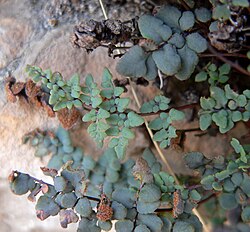Taxonomy
The group of species comprising the genus was first described by John Smith in 1842 as Notholaena sect. Argyrochosma. He included in the genus species with a variety of coverings on the undersurface of the leaf, and assigned to this section those that were covered in white farina. Smith's name is derived from the Greek words ἄργυρος (argyros), "silver" and χῶσμα (chosma), "mound of earth". [a] Carl Christensen considered the section to be more properly classified in Pellaea , and designated Pellaea nivea as the lectotype for it.
By the late 20th century, most authorities favored placement of a group of ferns, exemplified by Notholaena nivea , either in Notholaena or Pellaea. Both Edwin Copeland and C. A. Weatherby suggested in the 1940s that the group might represent a distinct genus of its own. In 1948, Weatherby advised Conrad Vernon Morton, preparing some treatments of American ferns, that these species, including some similar to N. nivea but without farina, were better placed as a section of Pellaea than in Notholaena. In the following year, he advised Morton that "this is one of the two groups (and the better of the two) which I can see clearly as a segregate genus...which...should bear the name Argyrochosma (J. Smith). I may live to publish on this." He did not, and so the task was addressed in 1987 by Michael D. Windham, who was carrying out phylogenetic studies of these genera. He elevated Notholaena sect. Argyrochosma to become the genus Argyrochosma and made suitable combinations for the recognized species. Two varieties of Argyrochosma nivea were transferred to the new genus in 1996 by M. Mónica Ponce, and subsequently elevated to species level in the genus in 2017 by Michael Kessler and Alan R. Smith. Meanwhile, in 2015, Gangmin Zhang and co-workers identified Argyrochosma connectens , a rare Chinese species formerly placed in Pellaea, as a member of the genus by DNA analysis.
Members of the genus Argyrochosma are commonly known as false cloak ferns or silver ferns. "False cloak fern" refers to the historical placement of these species in the genus Notholaena. The name of that genus is derived from Greek, meaning "false cloak", referring to the fact that the sori are not covered by well-differentiated tissue of the leaf margin, and its species were commonly known as "cloak ferns". "Silver fern" is evidently derived from the name Argyrochosma, which means "silver mound" and refers to the white farina found on the underside of the leaves of most species.
This page is based on this
Wikipedia article Text is available under the
CC BY-SA 4.0 license; additional terms may apply.
Images, videos and audio are available under their respective licenses.
